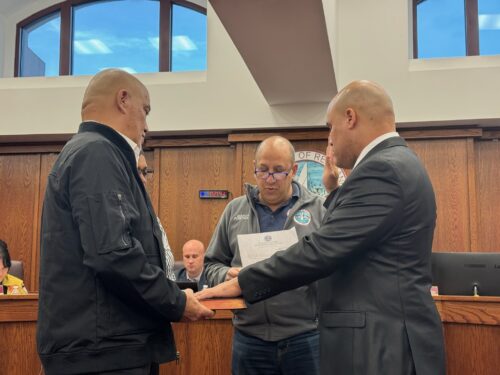By LINDA G. RASTELLI
Sea Bright taxpayers paid $75,000 for each of the 24 students who attended Shore Regional High School last year. The school’s cost to educate them was only $13,000.
In running for mayor last year, Maria Fernandes promised that the first thing she’d do if elected would be to work on changing the T&E (thorough and efficient funding) formula in Trenton. And in her first speech as mayor on January 5, she announced a new School Funding Advisory Committee.
As chair of the new committee, Councilwoman Dina Long outlined four possible objectives Monday night for its first year that Fernandes praised as comprehensive.
The T&E formula was instituted in the early ’90s, and bases what each town pays on an equalized value of the property in that town, Long said. That approach, she said, “is skewed, and doesnt reflect our ability to pay.”
During her mayoral campaign, Fernandes attacked the school funding formula as “outrageous,” and suggested working to change state law, which she says makes Sea Bright a”cash cow” for Monmouth Beach, Oceanport, West Long Branch, the other towns which use the high school.
A successful referendum to release Sea Bright from the arrangement would result in a $1.5 million deficit for the other towns, Long explained clearly a dealbreaker for them.
Corzines new funding plan increases aid slightly for “so-called wealthy districts,” Long said, but “it doesn’t help the problem for towns like us. It doesn’t address the fundamental problem.”
She said the committee would explore all possible avenues, and hopes to present an equitable alternative to the current funding formula.
It will even be revisiting the idea of a lawsuit, which the council decided against in 2003.
“We’d like to change the formula, but realistically, what can we do in one year?” Long asked in proposing her objectives for the committee’s first year.
Fernandes has already appointed several local residents who bring different skills and experience to the table, Long said. “It’s a combination of retired teachers, administrators, some finance and some law, and someone with a public relations background” to help with media. Meetings are on the first and third Saturdays of each month.
“This strong committee of dedicated residents will develop a long-term plan for securing state changes a plan that may involve other municipalities in inequitable regionalized agreements such as ours,” she said in her speech. “Resolving this imbalance requires us to stop simply complaining about it, but instead let’s initiate a plan of action.”
Longs “measurable objectives” for the group include an “organized alliance with other small towns and school districts in central New Jersey and Cape May County” so they can compare and analyze data; investigating funding mechanisms in other states “so we can offer some reasonable alternative or things to talk about rather than just saying the formula is not fair;” seeking opportunities to influence state legislators, either one-on-one or testifying before committees; and “making some noise” in the press about this issue.
Long said her committee was looking to form an informal alliance with towns that are in the same boat as Sea Bright, such as small beach towns on Long Beach Island and in Cape May county, but hasn’t actually contacted anyone yet. “That’s what we’ll be doing,” she said.
“Getting a voice with our legislators is key,” responded Councilwoman Peggy Bills. Other council members agreed to contact Long with their input on her suggestions.
Bills voted Tuesday night on some minor resolutions, although she abstained from voting at the council’s reorganization meeting, as did Republican council members Brian Kelly and Jack Keeler, who were absent during the voting this week. Former council president Keeler cited the pending Superior Court action by former mayor Jo-Ann Kalaka Adams that seeks to invalidate the mayoral election she narrowly lost after a recount.






















